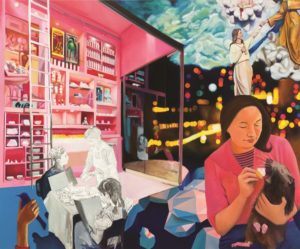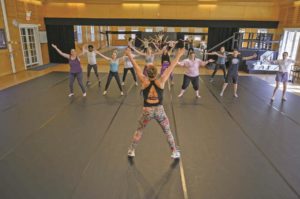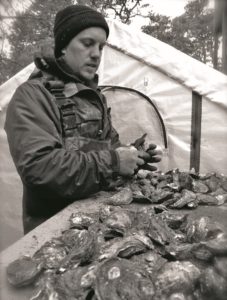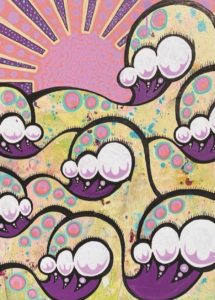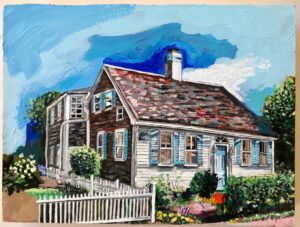In early April, Liz Carney visited Italy for the first time on a trip organized by Provincetown yoga teacher Beth Goldstein. Her plan was to combine travel, yoga, and plein air painting.
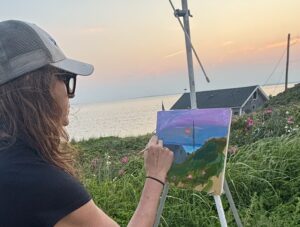
Although Italy was new to Carney, painting outdoors was not. The owner and director of Four Eleven Gallery, she is known for her oil paintings, acrylics, and watercolors that hover between abstraction and observation. “Painting from observation is the way in for me,” she says. “It gives me something concrete to hold on to, allowing a whole undercurrent of experience to enter.”
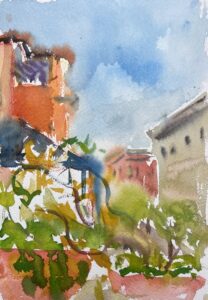
Carney grew up as the youngest of nine daughters in an Irish family in Dorchester. Of all the siblings, Carney spent the most time in the family’s Provincetown summer home at 411 Commercial St. Her mother, Madelyn Carney, was a painter and art educator who studied with Henry Hensche and Jim Forsberg. She purchased the three-story bayside guest house from painters Helen Daphnis-Avlon and Nassos Daphnis almost 50 years ago. Madelyn rented rooms to artists and writers.
In 2011, Liz Carney opened Four Eleven Gallery in what was once the building’s first-floor apartment. It has the feeling of an artist-run space. Carney will be showing a series of watercolors from Italy there this month.
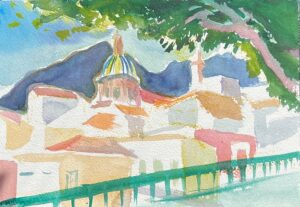
In Italy, Carney made spontaneous stops to paint. She captured the texture of towns and villages in central and southern Italy with fast-drying watercolors, her go-to travel medium. On the Amalfi Coast, she painted a cathedral from a park. Her loosely painted watercolor leads the eye from an overhanging tree to a small Duomo emerging from rows of dwellings. Purplish-blue hills lie in the distance. The painting is an example of the peaceful vistas she was drawn to on the journey.

“There are times painting plein air when I am feeling pure joy,” Carney says. “I would put a few marks down, then walk 20 feet and return to the canvas. There is a dance in the act of painting, even in the movement of the arm.”
While Carney doesn’t consider herself an abstract expressionist, mid-20th century painters like Jackson Pollock and Helen Frankenthaler would agree with the dance-like connection between body and brush. Carney calls it a “flow state.”
It’s evident in Madelyn’s Garden, one of many views she painted around Four Eleven Gallery. Her paintings often are meditations on her connection to her mother. They include Madelyn’s Daylilies and Lavender, In Memory of Madelyn, and Sitting in Madelyn’s Garden.

Madelyn encouraged her youngest daughter’s early interest in art, getting her paints and taking her to the Fenway Art Studios as a teenager. Less than a decade later, Liz was enrolled at Smith College, taking studio art classes. While she never went painting with her mother, “she gave me some of the best critiques of my life,” Carney says.
She recalls watching her mother looking out the dining room windows, painting Provincetown Harbor and MacMillan Pier. As a young painter, Carney flipped the vantage point, often painting from the pier looking east toward 411 Commercial St.
“It occurred to me many years later that I was painting back; it was as if I was thinking she could see me from the house,” says Carney of this memory. “ ‘I’m out there. See me, see me.’ ”
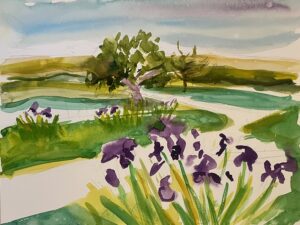
In her upcoming exhibition, titled “Heirloom,” Carney will show her work alongside that of Ella Grimm, a student of art and architecture at Cornell University and the daughter of painter Helen Grimm, a stalwart at Four Eleven since it opened.
“Ella and I both think of an heirloom as an object, a thing,” Carney says, “like a piece of jewelry. But we both have mothers who are painters. In each of us, there is a deep desire to paint. So, for us, an heirloom is what is inside, like an heirloom seed.”
When her mother died in 2021, Carney, who had been caring for both her parents in their Dorchester home, was eager for a fresh start. That resulted in a move in January 2024 to Petersham, a town of just over 1,000 residents. Plans are underway for a new studio, retrofitted within a large, wood-framed structure, that had been a horse barn. The previous owners left their woodworking tools, perfect for Carney, who often paints on wood panels.
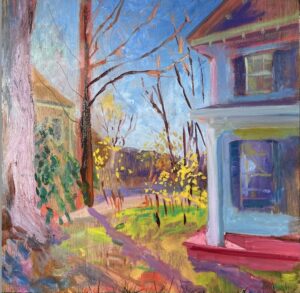
One of her recent paintings, a view from her house on the Petersham green, captures a bright spring afternoon. The painting, It’s Good to Be Home, is a peaceful scene, both realistic and abstract. Blues, reds, and yellows offer a glimpse of Carney’s two-story house. The structure is angled, revealing a pathway leading to creamy yellow dots of forsythia. Here, too, she’s using painting as a way into experience — a new season and a new home.
Going With the Flow
The event: “Heirloom,” watercolors by Liz Carney and oil paintings by Ella Grimm
The time: Through Aug. 7; opening reception Friday, July 25, 7 to 9 p.m.
The place: Four Eleven Gallery, 411 Commercial St., Provincetown
The cost: Free
